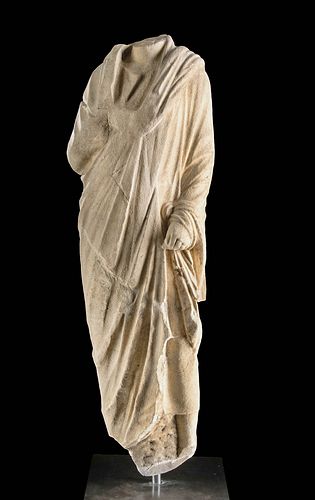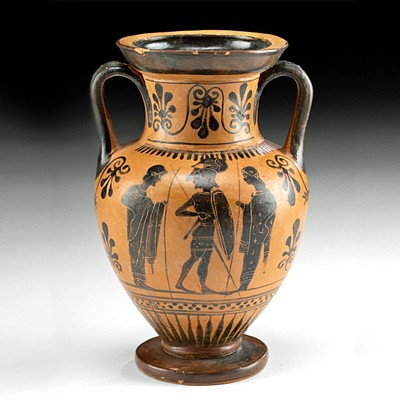Lifesize Roman Marble Togatus (Man Wearing Toga)
Lot 51
About Seller
Artemis Fine Arts
686 S Taylor Ave, Ste 106
Louisville, CO 80027
United States
Selling antiquities, ancient and ethnographic art online since 1993, Artemis Gallery specializes in Classical Antiquities (Egyptian, Greek, Roman, Near Eastern), Asian, Pre-Columbian, African / Tribal / Oceanographic art. Our extensive inventory includes pottery, stone, metal, wood, glass and textil...Read more
Estimate:
$80,000 - $100,000
Absentee vs Live bid
Two ways to bid:
- Leave a max absentee bid and the platform will bid on your behalf up to your maximum bid during the live auction.
- Bid live during the auction and your bids will be submitted real-time to the auctioneer.
Bid Increments
| Price | Bid Increment |
|---|---|
| $0 | $25 |
| $300 | $50 |
| $1,000 | $100 |
| $2,000 | $250 |
| $5,000 | $500 |
| $10,000 | $1,000 |
| $20,000 | $2,500 |
| $50,000 | $5,000 |
| $100,000 | $10,000 |
| $200,000 | $20,000 |
About Auction
By Artemis Fine Arts
Mar 9, 2023
Set Reminder
2023-03-09 10:00:00
2023-03-09 10:00:00
America/New_York
Bidsquare
Bidsquare : Exceptional Ancient, Ethnographic, & Fine Art
https://www.bidsquare.com/auctions/artemis-gallery/exceptional-ancient-ethnographic-fine-art-12354
Artemis Fine Arts info@artemisfinearts.com
Artemis Fine Arts info@artemisfinearts.com
- Lot Description
**Originally Listed At $50000**
*This item may be oversized. Please inquire about shipping prior to bidding.
Roman, Imperial Period, ca. 1st to 3rd century CE. A finely carved, LIFE-SIZE marble torso of a figure donning a voluminous toga draped across the body with cascading folds, the left leg bent at the knee with a section of the calf revealed beneath the hemline. The togatus figure's left hand wears a ring on the fourth finger (perhaps a wedding ring) and grips a cluster of drapery folds, perhaps to make it easier to stride forward, while the right hand, which may have been shrouded by the toga, is positioned near the cowl and opposite end of the garment. The sculptor also took great care to depict the fingers of the hand in a lifelike manner, and the bent knee suggests that the sculptor depicted the figure in a contrapposto pose. This weight shift suggests the natural, organic movement of the human body. The Greeks invented this pose in the 5th century BCE as an alternative to the more static stances of earlier eras. By the 4th century BCE, Praxiteles and others mastered this expressive pose, and the Romans of course admired this ability to capture the human figure in a veristic fashion. Size: 12.875" L x 15.875" W x 53.5" H (32.7 cm x 40.3 cm x 135.9 cm); 76.5" H (194.3 cm) on included custom stand.
The wearing of the toga in Imperial Rome dates to the time of Emperor Augustus (reign 27 BCE to 14 CE), when he revived an ancient costume and made it required attire in the Forum. Hence, this figure's toga associates him with the public life of the Empire. A remarkable sculpture that likely once graced a public space to commemorate a notable figure.
Provenance: ex-Merrin Gallery, NYC, New York, 1980s to 1990s
All items legal to buy/sell under U.S. Statute covering cultural patrimony Code 2600, CHAPTER 14, and are guaranteed to be as described or your money back.
A Certificate of Authenticity will accompany all winning bids.
We ship worldwide and handle all shipping in-house for your convenience.
#162658Area of repair to back and display stand (not shown in photos). A very nice section from an even larger statue - missing head and lower legs/feet as shown. Losses to edges of toga pleats and other high-pointed areas such as that near the right hand, which may have been shrouded by the toga, and the knuckles on left hand. Ring on ring finger is intact (how nice)! Surface fissures and faults in stone visible from aging. Expected surface wear with abraded areas commensurate with age.Condition
- Shipping Info
-
All shipping is handled in-house for your convenience. Your invoice from Artemis Gallery will include shipping calculation instructions. If in doubt, please inquire BEFORE bidding for estimated shipping costs for individual items.
-
- Buyer's Premium



 EUR
EUR CAD
CAD AUD
AUD GBP
GBP MXN
MXN HKD
HKD CNY
CNY MYR
MYR SEK
SEK SGD
SGD CHF
CHF THB
THB















